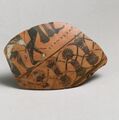Instrumentum domesticum
Topic: Earth
 From HandWiki - Reading time: 2 min
From HandWiki - Reading time: 2 min

In archaeology, instrumentum domesticum (or simply instrumentum) refers to instruments, tools, and other artifacts intended for ordinary and domestic use (as opposed, for instance, to objects with religious, ceremonial, or monumental purposes). It also includes replicas of such objects made to be deposited in graves.[1][2][3] The name is Latin for "domestic instruments", a term originally defined by Roman Law.[1]
In epigraphy and paleography, the term refers to inscriptions that were written on such objects at or near the time of their use. In this sense, it also includes inscriptions in oracular objects (like the sortes of the Romans), talismans, and personal spells (like the Roman and Greek curse tablets). It does not however include objects whose function was to carry text, such as writing tablets and books.[1]
Gallery
Clay replica of a serving tray (foculum) made for furnishing an Etruscan grave. The original tray and utensils may have been made of wood, metal, or other materials. Chiusi, Tomb A Group, 550-500 BCE.
Maya chocolate cup with mythological scene and Mayan glyphs. El Zotz region, Guatemala, 650-800 CE.
Hand mirror, Romano-Celtic culture, found at Desborough, England . 50 BCE - 50 CE.
References
- ↑ 1.0 1.1 1.2 Giuseppe Pucci (2001): "Inscribed instrumentum and the ancient economy"; doi:10.4324/9780203086445. Chapter 6 of Ancient History From Inscriptions: Ancient History From Inscriptions, edited by John Bodel. Routledge; 272 pages ISBN 9780203086445
- ↑ Robin George Collingwood (1995): The Roman Inscriptions of Britain: Instrumentum domesticum (Personal belongings and the like). Graffiti on coarse pottery cut before and after firing, Stamp on coarse pottery, Addenda and corrigenda to fascicules 1-8 (RIB 2502-2505), Volume 2, Part 8. Published by Administrators of the Haverfield Bequest; 165 pages. ISBN 9780750909167
- ↑ (2019) "instrumentum domesticum", article in the Italian Wikipedia. Accessed on 2019-04-26
 |
 KSF
KSF



